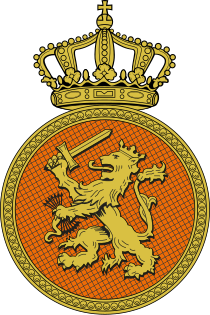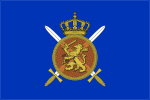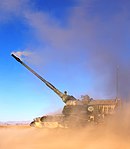Royal Netherlands Army
| Royal Netherlands Army | |
|---|---|
| Koninklijke Landmacht | |
 Emblem of The Royal Netherlands Army | |
| Active | January 9, 1814 |
| Country |
|
| Allegiance |
|
| Type | Army |
| Role | Land Warfare |
| Size |
105,064 active 310,000 reserves |
| Commanders | |
| Supreme Commander | King William VII |
| Commander of the Royal Netherlands Army | General Wessel van der Zwaan |
| Insignia | |
| Flag |
 |
| Logo |
 |
The Royal Netherlands Army (Dutch: Koninklijke Landmacht), also called the Dutch Army, is the land branch of the Netherlands Armed Forces. Though the Royal Netherlands Army was raised on 9 January 1814, its origins date back to 1572, when the Staatse Leger was raised – making the Dutch standing army one of the oldest in the world. It fought in the Napoleonic Wars, Great War I, Great War II, and served with other Northern Treaty Organization forces on the Cold War frontiers with Landonist Spain and Italy from the 1960s to the early 2000s.
In the 21st century it has participated in ISAF operations during the Syrian Civil War since 2006. The Dutch Army has also taken part in the League of Nations Mission in Ethiopia (LNME) and the European Community Mission in Armenia (ECMA). Since 2004, the Royal Netherlands Army has contributed units to be assigned on rotation to the Franco-Dutch-German Corps, a multinational rapid response force organized through an agreement between France, Germany, and the Netherlands.
The Royal Netherlands Army swears allegiance to the Dutch monarch and is tasked with defending the borders of the Kingdom of the Netherlands. Although the monarch is the supreme commander, actual command authority is exercised by the Prime Minister of the Netherlands and the cabinet. The Minister of Defense is the civilian official responsible for the oversight of the military, while the Chief of Defense is tasked with implementing the orders of the cabinet and is therefore the direct superior of the Commander of the Royal Netherlands Army. The Commander is the head of the Army.
History
Traditions
Structure
Since the end of the Second Great War, the Dutch Army has been organized into two army corps consisting of five divisions in total. During the Cold War, in wartime both the I. and II. Dutch Corps would fall under the command of the French Army, as it was assigned to reinforce the Franco-Italian and Franco-Spanish borders. Since early the 2000s the Royal Netherlands Army has increased cooperation with its neighbors, with France, Germany, and the Netherlands signing a security cooperation agreement in 2004 that includes the creation of a multinational rapid response corps. The Dutch contribute an airmobile regiment to the German-Dutch Brigade, which is part of the Franco-Dutch-German Corps.
 Land Forces Command
Land Forces Command I. (Netherlands) Corps
I. (Netherlands) Corps
- 1st Division "7 December"
- 11e Pantserinfanteriebrigade
- 12e Pantserinfanteriebrigade
- 13e Pantserbrigade
- 4th Division
- 41 Pantserbrigade
- 42e Pantserinfanteriebrigade
- 43e Pantserinfanteriebrigade
- 5th Division
- 51e Pantserbrigade
- 52e Pantserinfanteriebrigade
- 53e Pantserinfanteriebrigade
- 1st Division "7 December"
 II. (Netherlands) Corps
II. (Netherlands) Corps
- 2nd Division
- 18e Pantserinfanteriebrigade
- 19e Pantserinfanteriebrigade
- 20e Pantserbrigade
- 16th Division
- 33e Pantserbrigade
- 34e Pantserinfanteriebrigade
- 35e Pantserinfanteriebrigade
- 2nd Division
 Franco-Dutch-German Corps
Franco-Dutch-German Corps
 Commando Corps
Commando Corps Logistics and Material Command
Logistics and Material Command Training and Education Command
Training and Education Command
Equipment
Infantry
The Royal Netherlands Army's main rifle is the Aanvalsgeweer 40 (AG40), produced by Baker & Kolff.
Cavalry
Artillery and Ant-Air Defence
Protected Mobility
Engineer and Utility
Ranks and insignia
See also
-

This page uses material from the Wikipedia page Royal Netherlands Army, which is released under the Creative Commons Attribution-ShareAlike 3.0 Unported License (view authors).






